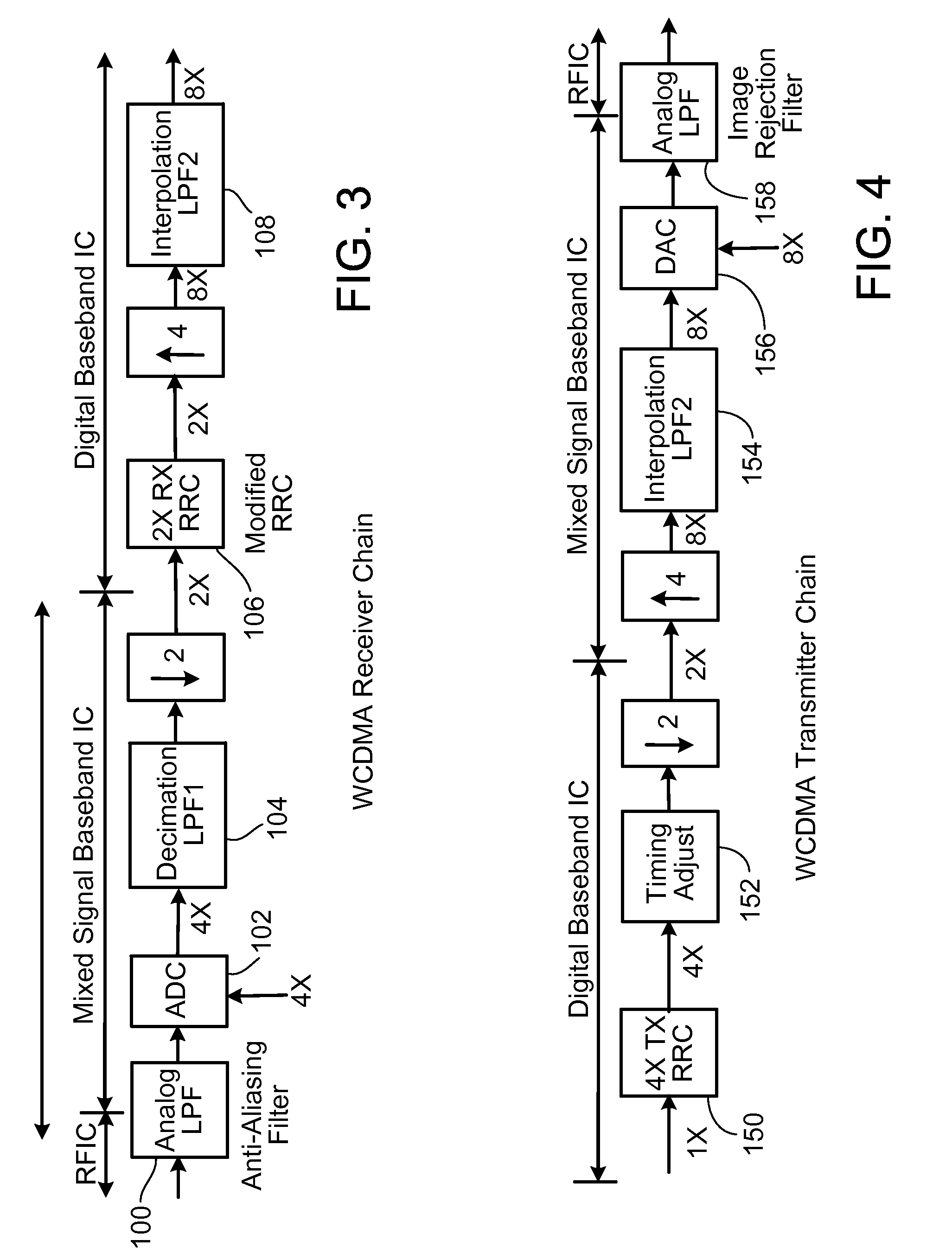Filters for communication systems
a filter and communication system technology, applied in the field of filtering for communication systems, can solve the problems of large number of filter coefficients, low over-sampling rate, large power and silicon area consumed by filter implementations, etc., and achieve the effect of reducing data traffi
- Summary
- Abstract
- Description
- Claims
- Application Information
AI Technical Summary
Benefits of technology
Problems solved by technology
Method used
Image
Examples
first embodiment
[0026]A block diagram of a WCDMA (wideband code division multiple access) receiver chain including a filter in accordance with the invention is shown in FIG. 3. The receiver chain includes an analog low pass filter 100, an analog-to-digital converter (ADC) 102, a decimation filter 104, a modified RRC digital filter 106 and an interpolation filter 108. The “modified” RRC filter refers to an RRC filter in which the coefficients have been modified to compensate for other components of the entire filter chain as described below. The analog low pass filter 100 is an anti-aliasing filter. The components of the receiver chain are cascaded, or connected in series, to provide and output data rate of 8×. The ADC 102 samples the analog signal at a 4× sampling rate in order to relax the requirement for the analog anti-aliasing filter. Decimation filter 104 may be a low pass filter (LPF) that produces a 2× reduction in data rate. The modified RRC digital filter 106 may be a finite impulse respon...
second embodiment
[0030]A block diagram of a WCDMA transmitter chain including a filter in accordance with the invention is shown in FIG. 4. The transmitter chain, which receives a digital signal at a 1× data rate, includes a 4× modified RRC digital filter 150, a timing adjust block 152, an interpolation filter 154, a digital-to-analog converter (DAC) 156 and an analog low pass filter 158. The output of the modified RRC digital filter 150 is supplied to timing adjust block 152 at a 4× data rate. After the timing adjustment, the data rate is reduced to a 2× rate so that the communication between digital baseband and analog baseband ICs is at the lowest rate (i.e. 2× rate) possible. Interpolation filter 154 increases the data rate from 2× to 8×. The DAC 156 has a sampling rate of 8× and provides an analog signal to analog low pass filter 158, which functions as an image rejection filter. The high sampling rate of 8× with DAC 156 relaxes the requirement for the image rejection analog low pass filter. Th...
third embodiment
[0033]A block diagram of a TDSCDMA (time division synchronous code division multiple access) receiver chain including a filter in accordance with the invention is shown in FIG. 5. The receiver chain includes an analog low pass filter 200, an ADC 202, a decimation filter 204 and a 2× modified RRC digital filter 206. Unlike the WCDMA receiver, no following interpolation filter is required since rest of the TDSCDMA receiver only requires a 2× data stream. The analog low pass filter 200 functions as an anti-aliasing filter. The ADC 202 has a sampling rate of 4× in order to relax the requirement for the analog anti-aliasing filter. The decimation filter 204 receives the output of ADC 202 at a 4× data rate and reduces the data rate to 2×, thereby supplying samples to the modified RRC digital filter 206 at a 2× data rate. The ADC 202 and the decimation filter 204 are implemented in a mixed signal baseband integrated circuit. The modified RRC digital filter 206 is implemented in a digital b...
PUM
 Login to View More
Login to View More Abstract
Description
Claims
Application Information
 Login to View More
Login to View More - R&D
- Intellectual Property
- Life Sciences
- Materials
- Tech Scout
- Unparalleled Data Quality
- Higher Quality Content
- 60% Fewer Hallucinations
Browse by: Latest US Patents, China's latest patents, Technical Efficacy Thesaurus, Application Domain, Technology Topic, Popular Technical Reports.
© 2025 PatSnap. All rights reserved.Legal|Privacy policy|Modern Slavery Act Transparency Statement|Sitemap|About US| Contact US: help@patsnap.com



